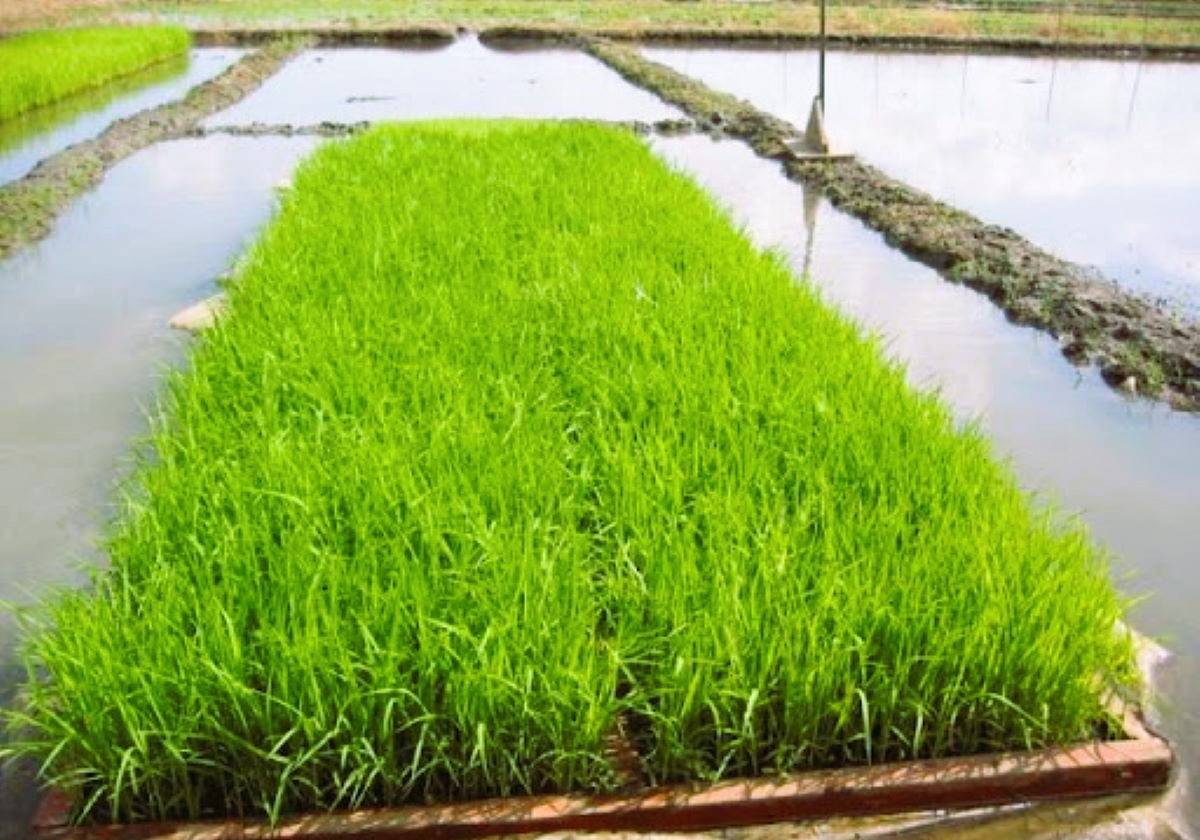
A healthy paddy nursery is the first and most important step towards achieving higher yields of the paddy crop. It is common for paddy nurseries to suffer from a lack of nutrients, weed problems, and sparse seedling patches. These issues can lead to poor seedling growth, necessitating farmers to purchase seedlings from other sources or farmers during the transplanting of paddy. Therefore, it is crucial to examine various management practices for sowing paddy nurseries to ensure healthy paddy seedlings. The techniques recommended by PAU, Ludhiana for producing healthy paddy nurseries are as follows:
Selection of Site for Paddy Nursery
After harvesting wheat, farmers should start preparing for the main crop of kharif i.e. paddy. It is essential to level the field before planting paddy seedlings. This leads to judicious use of fertilizers along with saving water. To achieve a higher yield of the paddy crop, the seed should be healthy and pure. Choosing a suitable field for a paddy nursery is vitally important. Paddy nursery should not be sown under shade and near straw heaps. For sowing paddy nursery, the field should be close to the water source and free from pebbles and weeds.
A Reliable Source of Seed
To obtain maximum yield from any crop, the seed must be healthy, pure and weedless. Healthy seeds should be procured from reliable sources such as Punjab Agricultural University, etc. If the paddy seed of the desired variety has been kept by the farmer from the previous year crop, a farmer must check the seed is free from any disease, pest attack and weed seed mixture. The true seed should have 98% purity (free from other crop seeds, seed mixture and weed seed) and 80% germination capacity.
Selection of Varieties and Time of Sowing
Less time-consuming varieties save 15-25% water and provide enough time for the management of the stubble, and the next crop is sown on time. The time of sowing of the crop plays an important role, which affecting the yield of that crop. Early sowing of seedlings not only requires more water but also increases the incidence of pests and diseases. Unproven varieties are unable to resist various diseases. To save natural resources, we should avoid cultivating long-duration varieties like Pusa 44, Dogar Pusa, and Yellow Pusa, etc. The details of the recommended paddy varieties are as follows.
Table 1. Recommended Paddy Varieties
|
Variety |
Sowing time |
Transplanting age |
Average Yield (q/acre) |
Harvesting time (After transplanting) |
|
PR 131 |
20-25 May |
30-35 days |
31.0 |
110 |
|
PR129 |
30.0 |
108 |
||
|
PR 128 |
30.5 |
111 |
||
|
PR 122 |
31.5 |
117 |
||
|
PR 121 |
30.5 |
110 |
||
|
PR 114 |
27.5 |
115 |
||
|
PR 113 |
28.0 |
112 |
||
|
PR 130 |
25-31 May |
30.0 |
105 |
|
|
HKR 47 |
29.5 |
104 |
||
|
PR 127 |
30.0 |
107 |
||
|
PR 126 |
25 May-20 June |
25-30 Day |
30.0 |
93 |
Method of Preparation & Sowing of Field
In the paddy nursery field, it is recommended to mix well-rotten farmyard manure (FYM) at a rate of 12-15 tonnes per acre by ploughing the field twice followed by irrigation. This encourages the germination of weeds and the previous year's paddy crop seeds. However, due to the shortage of milch animals, there is a scarcity of FYM, and farmers have to rely on chemical fertilizers to meet the nutrient requirements for the paddy nursery. To fulfil the nutrient requirements, apply 26 kg of urea and 60 kg of superphosphate per acre at the time of the puddling.
Additionally, adding 40 kg of zinc sulphate heptahydrate (21%) or 25.5 kg of zinc sulphate monohydrate (33%) does not cause zinc deficiency in the seedlings. To ensure proper growth, broadcast 8 kg of treated and pre-germinated seeds in about six and a half marlas to raise nursery for one acre. It has been observed that in light textured soils, farmers follow the practice of broadcasting the seed after planking the field twice or thrice followed by irrigation. Consequent to this practice iron deficiency occur in seedling resulting into poor growth of paddy seedlings. Thus on light textured soil’s to prevent the iron deficiency in nursery, farmers can puddle the field before sowing or can spray the iron sulphate.
Weed control
The growth of various types of weeds in paddy nurseries is a major concern that affects the quality and yield of the crop. Among the weeds, Swank and some other annual grasses are the most problematic. To control the weeds effectively apply 1200 ml/acre of butachlor 50 EC mixed with 60 kg of sand, seven days after broadcasting the seeds. Alternatively, a sand mix of 500 ml/acre of Sofit 37.5 EC (Pertilachlor+safener ready mix) can be applied three days after sowing or spray 100 ml/acre of nominee gold 10 SC (bispyribac) in 150 litres of water at 15-20 days after sowing.
Irrigation and micronutrient management
It is important to keep the seedlings hydrated by watering them as needed, but make sure not to let water stand continuously. In sandy soil, iron deficiency may appear which can cause the leaves of paddy seedlings to turn light yellow or white. To compensate for the iron deficiency, dissolve 0.5-1.0 kg of ferrous sulphate in 100 litres of water and spray it 2-3 times at weekly intervals. Additionally, there may also be a lack of zinc in the seedlings, which can result in discolored leaves with rusty spots. To tackle this issue, spray a solution of 0.5% (half a kg of zinc sulphate heptahydrate (21%) or 0.3% zinc sulphate monohydrate (33%)) containing 300 grams of zinc sulphate monohydrate in 100 litres of water.
(Information shared by Amit Kaul, Mandeep Singh and Gagandeep Dhawan, Department of Agronomy and KVK Kapurthala, P.A.U., Ludhiana)
















